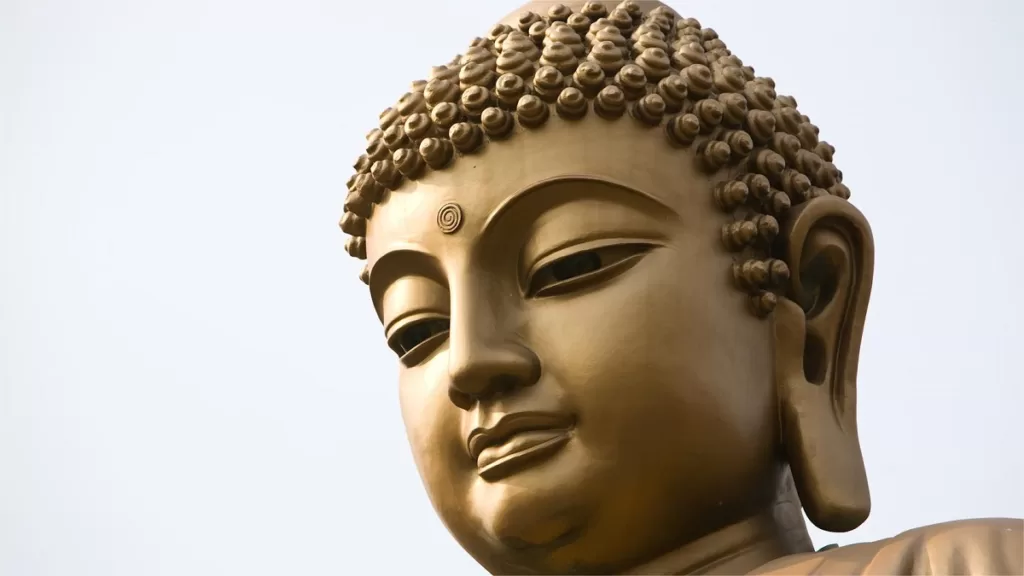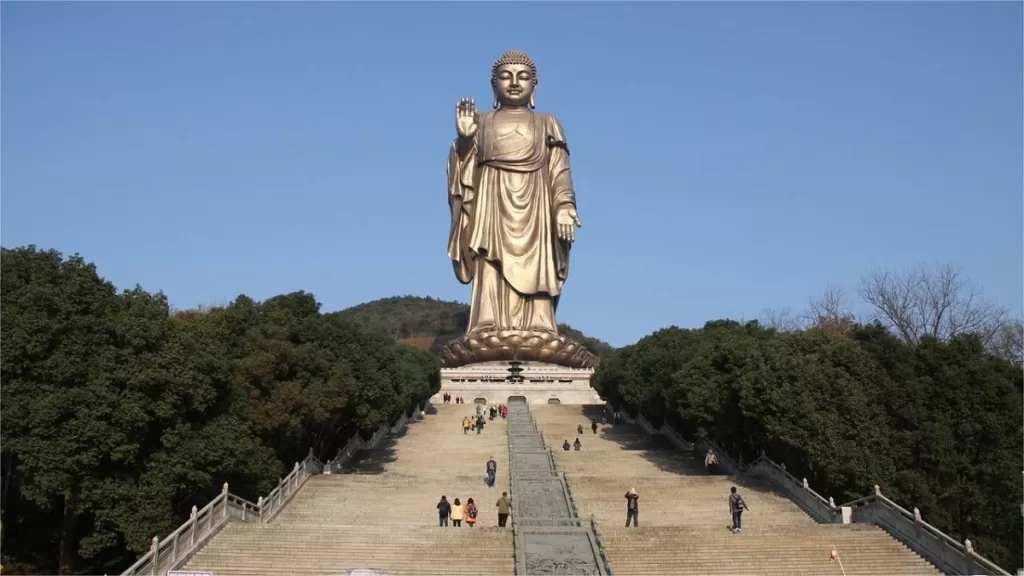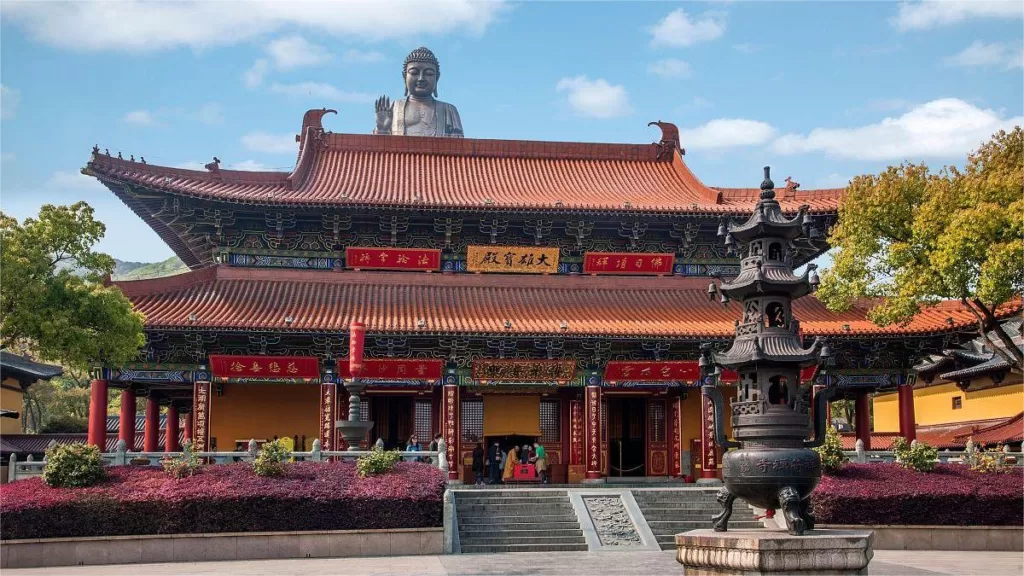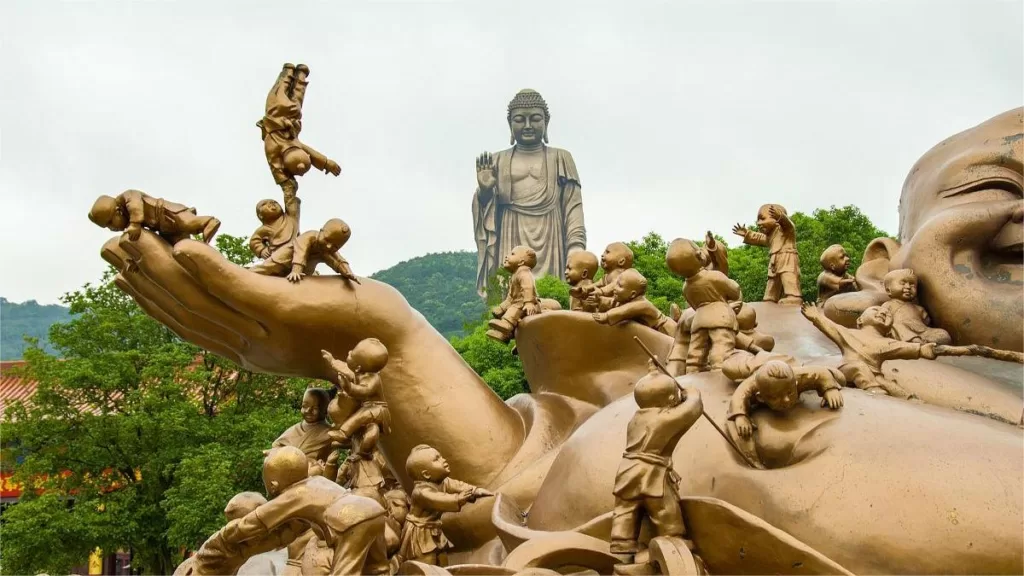Nestled in the serene landscapes of Wuxi, Jiangsu Province, China, the Lingshan Grand Buddha (灵山大佛) stands as a towering testament to spiritual devotion and artistic excellence. Located in the Binhu District, specifically in the Ma Shan Town at 1 Lingshan Road, this monumental masterpiece is a true marvel of engineering and artistry and a highlights of the Lingshan Scenic Area. Rising majestically with the vast expanse of Taihu Lake to its south and the protective embrace of Lingshan Mountain behind, the Lingshan Grand Buddha captivates visitors with its awe-inspiring presence.
Breathtaking Appearance
The Lingshan Grand Buddha is renowned worldwide as the tallest outdoor bronze statue of Shakyamuni Buddha. Its imposing height reaches a remarkable 88 meters, with the Buddha’s body standing at 79 meters, and a lotus petal base that spans 9 meters. Surpassing even the renowned Leshan Giant Buddha by an impressive 17 meters, this magnificent statue is a true marvel of craftsmanship and precision. It is composed of 1,560 copper panels, each ranging from 6 to 8 millimeters in thickness, meticulously welded together, with a combined seam length extending over 35 kilometers, achieving a seamless and flawless appearance that defies imagination.
Design and Construction

The Lingshan Grand Buddha comprises approximately 700 tons of copper, covering an area of more than 9,000 square meters, equivalent to the size of one and a half soccer fields. Throughout its construction, modern technology was harnessed to ensure its stability and resilience. Advanced measures for wind resistance, earthquake protection, and lightning prevention were meticulously incorporated into the statue’s design. Notably, lightning rods were ingeniously concealed within the Buddha’s hair, seamlessly blending function and aesthetics.
Symbolism
The Buddha’s right hand is raised in the “Abhaya Mudra” or the gesture of fearlessness, symbolizing the alleviation of suffering for all sentient beings. Conversely, the left hand is lowered in the “Varada Mudra” or the gesture of granting wishes, signifying the bestowal of peace and happiness upon humanity. Remarkably, regardless of where one stands, the Buddha’s “gaze” seems to follow visitors, a testament to the extraordinary skill of the sculptors who crafted this masterpiece.
Legends and Folklores

In local folklore and among visitors and devotees, numerous legends and auspicious signs surround the Lingshan Grand Buddha. Tales of miraculous events during its consecration and the auspicious weather during the grand ceremony when it was unveiled continue to captivate the imagination. The Lingshan Grand Buddha is not merely a statue but a convergence of culture, art, and religion, a magnificent artistic treasure of immense significance.
Dengyun Road
The journey to the feet of the Lingshan Grand Buddha is a profound experience in itself, with the “Dengyun Road” leading the way. Comprising a total of 216 steps divided into seven terraces, this staircase is a visual marvel. When viewed from below, the terraces seem to meld seamlessly into one another, giving the impression of a continuous ascent. Conversely, when seen from the top, the individual steps become indistinguishable from the terraces below, symbolizing the idea of “saving one soul leads to the construction of seven pagodas.”
Stone Carvings

Along the Dengyun Road, seven monumental stone carvings tell the captivating history of Lingshan, from the time of the Buddhist monk Xuanzang‘s disciple Kuiji’s efforts to spread Buddhism to the grand opening of the Lingshan Grand Buddha. In Buddhist tradition, it is believed that there are 108 kinds of afflictions and 108 kinds of aspirations in human life. Climbing the 216 steps symbolizes the transcending of afflictions and the fulfillment of aspirations, an ascent towards spiritual enlightenment.
Hexagonal Well
To the left of the Dengyun Road stands a historic well known as the “Hexagonal Well” or “Liujiao Well,” adorned with inscriptions. Historical records indicate that during the Tang Dynasty, monks from the Xiangfu Monastery dug this well in the western tea garden of the monastery for cooking and drinking purposes. It was even known as the “Tea House Well.” Legend has it that Lu Yu, the Sage of Tea, once tasted the well’s spring water and praised its sweetness and purity, elevating it to one of the top ten famous springs in Jiangnan.
Conclusion
The Lingshan Grand Buddha, with its towering presence and rich cultural and spiritual significance, is more than just a work of art—it is a symbol of serenity, enlightenment, and the enduring human quest for inner peace. It stands as a testament to the fusion of tradition and modernity, where ancient wisdom and contemporary engineering unite to create an iconic masterpiece that continues to inspire and captivate all who are fortunate enough to witness its magnificence. The Lingshan Grand Buddha is a living embodiment of the profound spiritual heritage of China and a beacon of tranquility for the world to behold.





